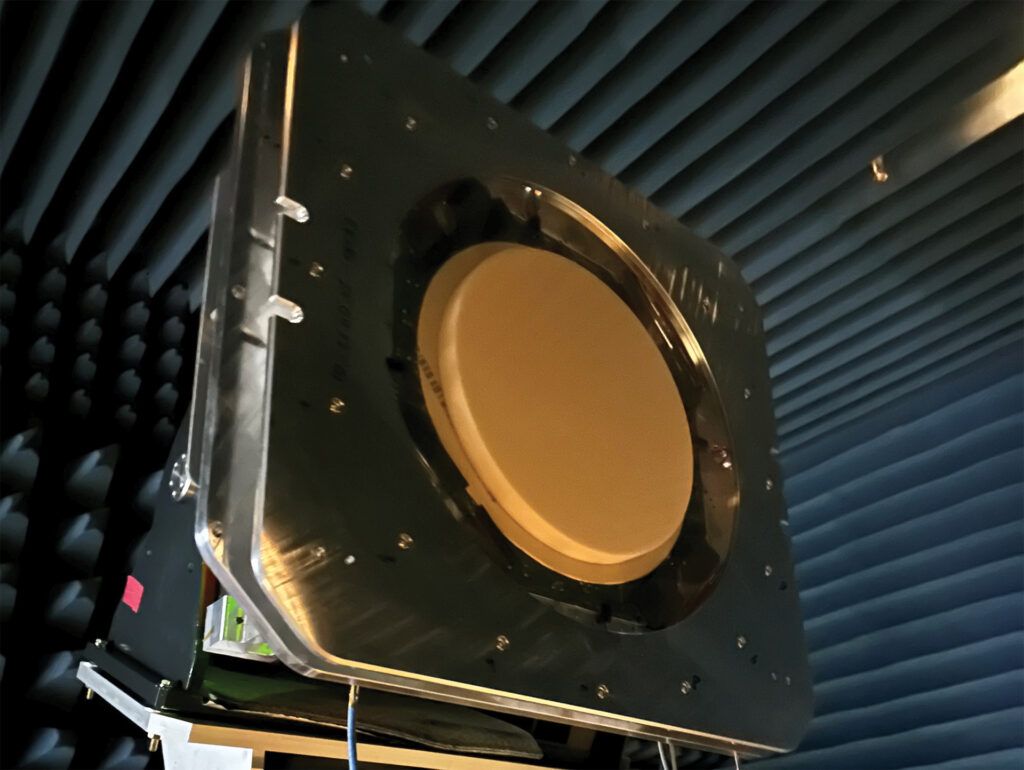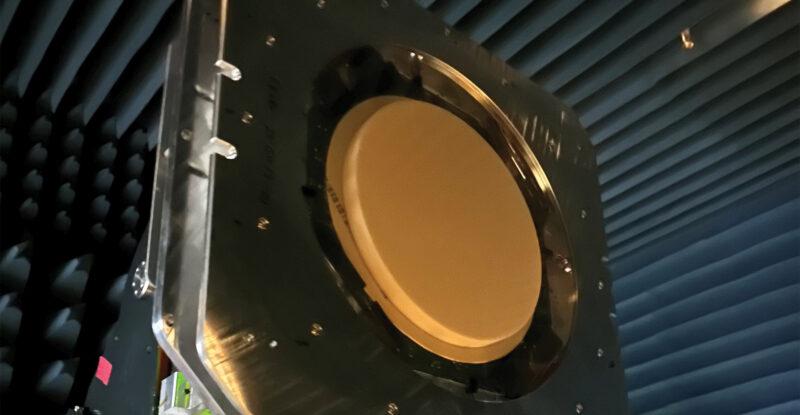The ability for a single compact electronically scanning antenna to simultaneously operate across Ku and Ka bands via satellites in multiple orbits is seen as somewhat of a Holy Grail solution in the defense sector. Airframers and managed service providers serving civil aviation have also expressed an interest in such functionality, though some see it as a few years away from being realized.
Now Kymeta Corporation is laying claim to having cracked the code, at least on the ground. During lab testing, the Redmond, Washington-based firm said it achieved multi-band connectivity with four concurrent beams in Ku- and Ka-band frequencies using a single antenna aperture. The kit is full duplex — i.e. able to transmit and receive simultaneously — on both the Ku beam and on the Ka beam. And it can do so whilst supporting multiple orbits or indeed a single orbit.
“This achievement was made possible by Kymeta’s unique metamaterials antenna surface,” the company explained in a statement. “Until this point, interoperability in the Ku and Ka bands has been possible only with Electronic Steered Antennas (ESA) using multiple physically separate antennas, which proves problematic due to the size and power usage required to operate. This technological disruption by Kymeta allows connectivity in both bands in one single antenna, giving space efficiency, low power consumption, and low cost (SWaP-C).”
Runway Girl Network sat down with Kymeta chief executive officer Rick Bergman and chief scientist Ryan Stevenson over a Teams video call to learn more. During the lab testing and validation exercise, which took place on 22 April 2025, Kymeta used “a core technology demonstrator,” Stevenson explained. “This is done on a scaled aperture size, and so the validation is done in our test facilities. And the next step going from here is to build a full-scale aperture that will connect to satellites.”
Though this is just “the very, very beginning” of the process, noted Bergman — and Kymeta must next work with satellite operators and potentially aero customers “and get precisely more what they want” including around size, power, orbits, and the various tradeoffs — the technology has proven to be “extremely flexible” and ticks the boxes for multi-band, multi-orbit, multi-beam and multi-network.
Defense first
Leveraging liquid crystal displays, Kymeta’s current-generation metamaterials-based flat-panel satellite terminals support connectivity for on-the-move platforms such as ships or military tactical vehicles. These terminals are capable of switching between multiple orbits and multiple networks, including the Eutelsat OneWeb Ku-band Low Earth Orbit (LEO) satellite constellation, for which Kymeta is a long-time partner.
“What we can’t do today is simultaneous,” said Bergman in reference to the existing, in-use hardware. “So, for example, our GEO/LEO terminal: we may have OneWeb and then, of course, we’ve also done an agreement with Intelsat for GEO. It’s just not simultaneous.”
As it develops its next-generation multi-band, multi-beam ESA, Kymeta is admittedly treating defense as the priority, with Bergman saying the firm has observed a “very, very clear need” as “they’re the ones that have defined this kind of vision for Ku-Ka for many, many years.”

The ability to connect to both Ku- and Ka-band beams will unlock higher bandwidth, faster data rates, and more bits per second (bps), said Kymeta, and meet the demands of global militaries. Image: Kymeta
Defense stakeholders are impressed. Noting that the U.S. DOD and defense forces around the globe require increasingly sophisticated, flexible and secure communications, which includes the need for high-performance, multi-band, multi-orbit connectivity from a single antenna, Eutelsat America Corp + OneWeb Technologies (EACOWT) president Ian Canning reckons the new ESA platform will be “truly disruptive” in defense.
For Intelsat CTO Bruno Fromon, Kymeta’s ability to unify Ku- and Ka- band connections through a single mobile antenna “is a foundational leap toward combined satellite networks, making communication as seamless and automatic as the cellular networks we use every day. This success is changing the game.”
Aero opportunity
But Kymeta also expects to create a family of products around the innovation, and consequently has started to reengage with potential partners in civil aviation.
“Frankly, there’s been a tremendous amount of enthusiasm,” Bergman revealed to RGN. “And so clearly, it’s a great match for our technology going forward. So aero is certainly rising in our importance as a market segment.”
Kymeta’s entry point could be either in business aviation or commercial aviation, he said, noting: “I think the market is changing a little bit, where there used to be much more onerous certifications and so forth.
“Those are still there, but companies like Starlink are starting to prove that you can move fairly quickly in the market. And it’s not a many-year process now. And so, whether it’s commercial work or business aviation… clearly, the size and power advantage that we bring has certain appeal to some of those markets as well.
High power consumption translates to heat problems and this is where a metamaterials-based ESA has advantages over, say, a multi-beam phased array antenna, where thermal challenges might mean gate-to-gate connectivity can’t be facilitated by the antenna alone.
“[T]he metamaterials technology clearly solves an issue in aero,” said Stevenson.
Added Bergman: “[O]nce you get that in your head about the flexibility and the power advantages and so on, it really appears that aero is an ideal implementation for that technology as well, given just the natural, of course, limitations that you face in that environment.
“So I think that matches the enthusiasm that we’re seeing from some of the technology providers out there.”
In aero, metasurfaces-focused antenna-maker Greenerwave is presently making headway, having recently partnered with Safran Passenger Innovations on a new Ka-band-specific aero terminal for airlines.
It’s also notable that a multi-band, multi-beam, multi-orbit and multi-network architecture is available from ThinKom Solutions’ ThinAir Plus line, which enables operators to pair — within the terminal package — a VICTS antenna with a LEO-only ESA. Delta Air Lines, working with aero ISP Hughes Network Systems, will bring the hybrid VICTS-ESA solution to its Boeing 717 fleet, as well as select Airbus A321neos and A350-1000s.
Additionally, it’s notable that airlines are growing more comfortable with less-traditional antenna configurations atop their aircraft, as evidenced by the dual phased array approach of Starlink Aviation for larger jets.
For its part, Kymeta reckons it can place two of its nextgen ESAs under the hood — in sync with the ARINC 791 spec — used for Ku- and Ka-band antenna installs, and support other possibilities atop the fuselage, ultimately even a conformal architecture.
Modem considerations
Kymeta’s hybrid Ku-Ka-band multi-beam antenna will initially be supported by two physical modems, Stevenson told RGN.
“At least at this point in time, two modems: so, you’ll have two signals, one coming off the Ku beam and one coming off the Ka beam,” he said. “And then what you choose to do from there, you can treat them differently as different data streams — and I know there’s sort of an emerging conversation in aero about maybe even having different connectivity providers on different beams, or different satellites coming into the aircraft — or you can bond them at the IP layer to increase your throughput.
“But what we’re looking forward to, and we’re a board level sponsor of DiFi as an example, to a point here in the near future where the modems are software-defined, and so you won’t need to have separate modems, and you can do more sophisticated signal routing, packet routing and processing and software.”
Added Bergman: “To put it simply, and in some ways, this is partly why we did the announcement: okay, we’re providing a software-defined antenna. In some ways, that’s the really hard part. It’s the RF. Now we need the modem folks to do similar. And as Ryan said, there’s some efforts, but we’d like to see those efforts speed up.
“The need is clearly there. Because, as you point out, we will invariably have to do a couple modems, even potentially more if we want a lot of options, which then kind of defeats some of the smaller area, potentially lesser power — those type of efforts that we’re moving forward.”
Some phased array aero antennas see the modem packaged closer to the antenna. Is that something that would be required, RGN asked Kymeta’s management?
“Certainly, for instances like OneWeb where the modem does need to be packaged right near the antenna, that would be the case, I think. I think for other constellations with different requirements on timing, you could put them further away, maybe somewhere in the cabin. So, I think the answer is, it depends,” replied Stevenson.

The physical area of Kymeta’s multi-band antenna aperture consists of four, interleaved sub-arrays — Ku transmit, Ku receive, Ka transmit and Ka receive — which allows for simultaneous and independently controlled Ku and Ka full duplex beams from its metamaterials surface. Image: Kymeta
One of the limitations of traditional phased array antennas is, of course, that they don’t always have full GEO coverage when operating in high latitudes. And from that perspective, Kymeta’s ESA is the same as any other ESA; it is constrained by geometry.
However, according to Bergman, “We tend to have better scan loss than a lot of other ESAs and so that helps. We manage our scan loss very well. Every flat panel ESA has to deal with this scan loss, right? But that’s where the LEOs come into play, and that’s where having a hybrid capability [makes sense]… On one band, if you can see a GEO, you know, we can connect to it, and then on the other band, let’s say we’re near the poles, and on Ku we want to switch over to the OneWeb network which has very good coverage over the poles, we can do that simultaneously.”
A pivot from liquid crystals
For its next generation, multi-band, multi-beam multi-orbit ESA, Kymeta will also be moving away from liquid crystals, Stevenson confirmed to RGN, explaining: “There’s environmental reasons why that makes sense, switching speed and making sure we can address the beam switching requirements of all the different constellations that are out there. I mean, obviously it works great on OneWeb right now, but there’s more demanding requirements out there that we’re addressing.
“And actually, we’re keeping pace with the display industry, and as the display industry migrates to mini-LED technologies and micro-LED technologies, we’re able to continue to leverage all of the investment the display industry has made in those technologies, and continue to advance our technology commensurately.”
Related Articles:
- French state to double stake in Eutelsat as LEO momentum clear
- Benefits of multi-orbit IFC explored at APEX TECH
- Air New Zealand commences trial of Starlink inflight Wi-Fi
- Royal Brunei taps Intelsat multi-orbit IFC for A320neo fleet
- Quvia sees aero following cruise with multiple connectivity providers
- JetBlue observes fundamental change in passenger behavior
- Viasat details Amara nextgen inflight connectivity strategy
- Panasonic, Airbus discuss possible interim solution for Ku HBCplus
- Intelsat linefit and SB wins see multi-orbit IFC come to E2, 787
- Kymeta eyes strategic integration partner in aero
Featured image credited to Kymeta












